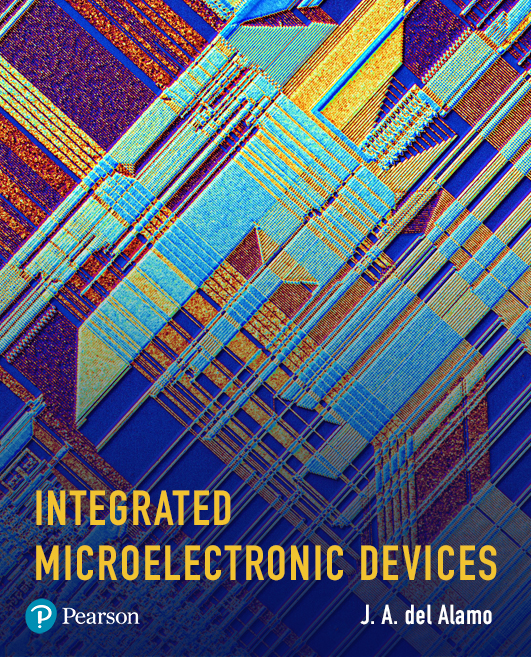
Integrated Microelectronic Devices: Physics and Modeling
by J. A. del Alamo, Pearson, 2017
Purchase at Amazon
Purchase at Pearson
Additional Instructor Resources (high-res graphics and problem solutions) at Pearson
A modern take on microelectronic device engineering
Microelectronics is a 50-year-old engineering discipline still undergoing rapid evolution and societal impact. Integrated Microelectronic Devices: Physics and Modeling fills the need for a rigorous description of semiconductor device physics that is relevant to modern nanoelectronics. Emphasis is devoted to frequency response, layout, geometrical effects, parasitic issues and modeling in integrated microelectronics devices (transistors and diodes). This book further aims to provide a realistic technology context for main stream devices: the metal-oxide-semiconductor field-effect transistor (MOSFET) and the bipolar junction transistor (BJT). The concepts learned here are highly applicable in other device contexts: solar cells, light emitting diodes, lasers, sensors, etc.
This book is based on the author’s experience in teaching 6.720J/3.43J Integrated Microelectronic Devices, a semester-long graduate student subject jointly offered in the Departments of Electrical Engineering and Computer Science (EECS) and Materials Science and Engineering (MS&E) at Massachusetts Institute of Technology (MIT). Typically, the class is composed of graduate students in EECS, Materials Science, Mechanical Engineering, Chemical Engineering and Physics plus a few seniors in the same departments. Graduate students in EECS and MS&E with interest in semiconductor materials and devices are strongly encouraged to take this subject their very first semester at MIT. While the book originated in a graduate course at MIT, it has been constructed to be productively used in an advanced undergraduate subject at the junior/senior level, as explained below.
There are two distinct parts to this book. The first five chapters introduce fundamental aspects of semiconductor physics pertaining to microelectronic devices: band structure, electron statistics, generation and recombination, drift and diffusion, and minority and majority carrier situations. Each chapter gives in its main body a general description suitable for a junior/senior-level or a first-year graduate course. These chapters also include at the end a number of advanced topics that can be selected individually to provide further depth. These can be the basis of a more advanced graduate subject.
Six device chapters follow with a similar outline. After a brief introductory section, the main body of the chapter presents a first-order, physically meaningful description of device physics and operation of an “ideal device”. The ideal device is stripped down to its very essence, preserving the key physics, and is analyzed in a simple and intuitive way. The ideal device, constructed and analyzed this way, constitutes an excellent vehicle to learn device physics at the junior/senior level. One or more sections follow that present significant non-idealities, important second-order effects and other considerations that are relevant in ''real" devices. These are suitable topics for graduate courses. To some extent, teachers of graduate subjects will be able to pick and choose topics from these latter sections since they are rather independent of each other. Every chapter finishes with a set of advanced topics that contain more advanced graduate-level material also amenable to individual selection.
With this organization, the text should be suitable for a one-semester junior/senior-level course by selecting the front sections of selected chapters (1 through 9 should be a popular set). At the same time, it could be used in a two-semester senior-level or a graduate-level course by taking advantage of the more advanced sections. In all cases, the book will provide plenty of reading material for personal study and future reference.
A detailed outline of the book is here.